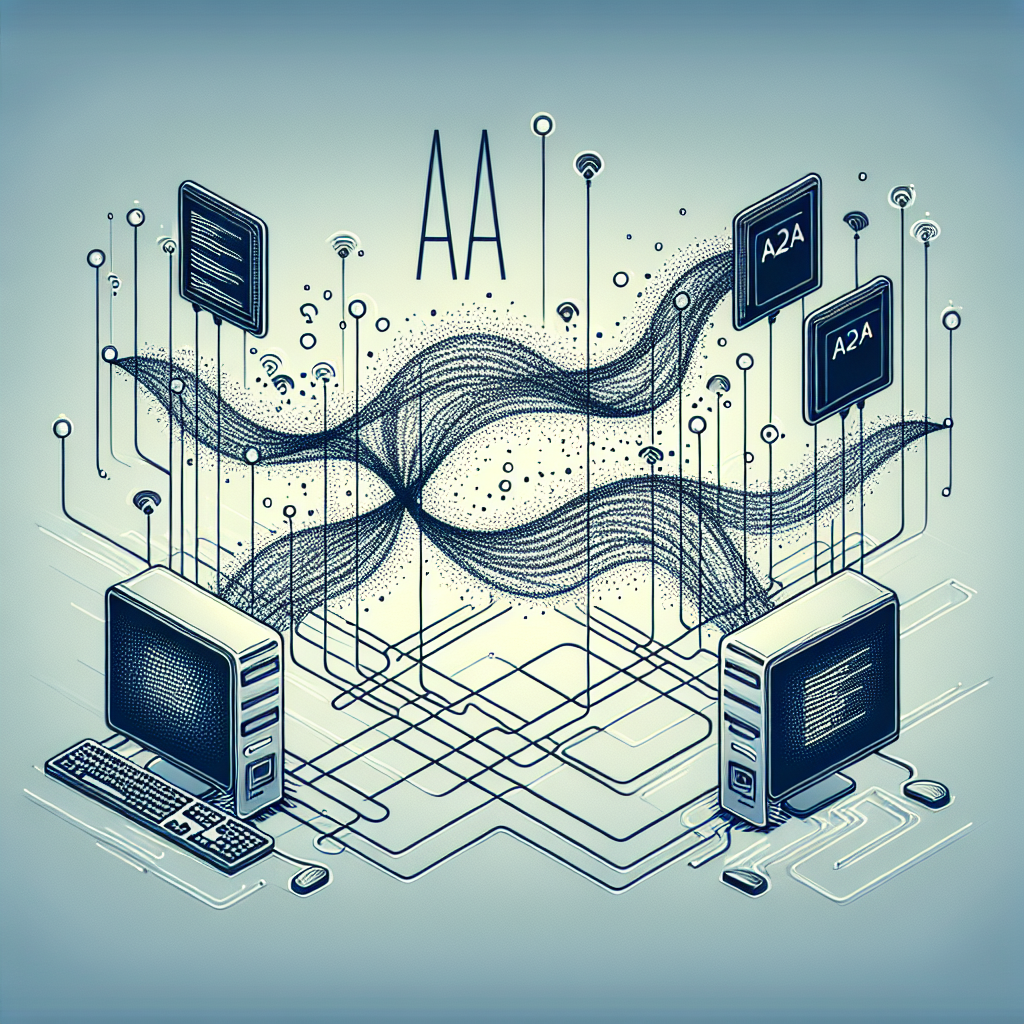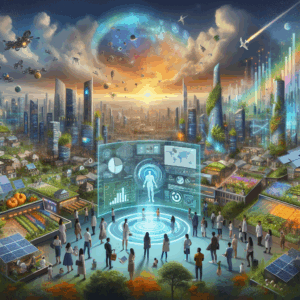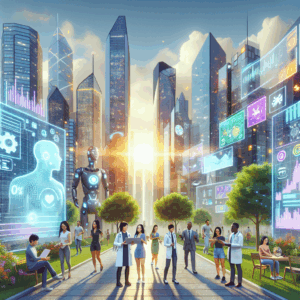Based on the research, I now have enough information to write a comprehensive blog post on Google’s new A2A protocol. Let me create the full article:
Understanding Google’s New A2A Protocol: A Game-Changer for AI Agent Collaboration
In the rapidly evolving landscape of artificial intelligence, Google has once again demonstrated its commitment to innovation with the release of its Agent2Agent (A2A) protocol. This groundbreaking open-source initiative is set to transform how AI agents communicate and collaborate, potentially reshaping how enterprises leverage AI systems. In this article, we’ll delve into what A2A is, how it works, and why it represents a significant leap forward for the AI industry.
Introduction: Google’s Latest AI Innovation
Google has long been at the forefront of technological advancements, particularly in the realm of artificial intelligence. Their latest offering, the Agent2Agent (A2A) protocol, introduced at Google Cloud Next ’25, represents a significant evolution in how AI systems interact with each other.
As AI becomes increasingly integrated into business operations, the need for seamless communication between different AI agents has grown exponentially. The A2A protocol addresses this challenge by providing a standardized framework for AI agents to exchange information and coordinate actions, regardless of which platform or framework they were built on.
Understanding the A2A Protocol
Definition and Overview
The Agent2Agent (A2A) protocol is an open standard specifically designed to enable interoperability between AI agents. At its core, A2A provides a common language and secure channel through which agents can communicate, regardless of their underlying frameworks or vendors.
Google designed A2A to address the challenges identified in deploying large-scale, multi-agent systems for enterprise customers. The protocol enables AI agents to securely exchange information, coordinate actions, and work together on complex tasks that might be beyond the capabilities of a single agent.
Goals of the A2A Protocol
The primary goals of the A2A protocol include:
- Creating a standardized communication framework for AI agents built on different platforms
- Enabling secure collaboration between agents in enterprise environments
- Supporting complex, long-running tasks that may span days, weeks, or even months
- Facilitating multimodal interactions where agents can share and process text, audio, and video
Technical Insights: How A2A Works
Technical Foundation
The A2A protocol is built on existing, widely-adopted standards:
- HTTP (Hypertext Transfer Protocol) for the base transport layer
- SSE (Server-Sent Events) for real-time updates and notifications
- JSON-RPC (JavaScript Object Notation Remote Procedure Call) for structured data exchange
By leveraging these established technologies, A2A makes integration with existing IT infrastructure relatively straightforward for businesses.
Key Features and Functionality
The A2A protocol introduces several distinctive technical features:
-
Agent Cards: AI agents advertise their capabilities, security permissions, and other relevant information through JSON-formatted Agent Cards, making it easy for other agents to understand what services they can provide.
-
Long-Running Task Support: Unlike traditional request-response protocols, A2A is designed to handle tasks that may take hours, days, or even longer to complete. Throughout extended processes, agents can provide real-time feedback, notifications, and state updates.
-
Enterprise-Grade Security: A2A incorporates authentication and authorization mechanisms with parity to OpenAPI’s authentication schemes, ensuring that only properly authenticated and authorized agents can participate in workflows or access sensitive data.
-
Multimodal Communication: The protocol supports not just text but also audio and video exchanges, enabling richer interactions between AI agents.
A2A vs. Traditional Protocols
Unlike traditional API interfaces that follow a simple request-response pattern, A2A creates a more dynamic, conversational flow between agents. This allows for:
- Ongoing dialogues rather than one-off exchanges
- Real-time status updates during long-running tasks
- Negotiation of capabilities between agents
- Secure contexts for multi-step workflows
A2A and MCP: Complementary Protocols
It’s worth noting that A2A is designed to complement, not compete with, Anthropic’s Model Context Protocol (MCP), which has gained significant traction in the AI community.
The key difference between these protocols lies in their focus:
- MCP functions as a “plugin system” for agents, providing tools and context to individual agents to enhance their capabilities.
- A2A serves as a “networking layer” for agents, helping them collaborate by giving them a shared language and secure channel for communication.
As one industry analyst summarized it: “MCP enables agents to use resources in a standard way. A2A enables those agents to collaborate with each other.”
Applications and Benefits of A2A
Real-World Applications
The A2A protocol opens up numerous possibilities for complex workflows that involve multiple specialized AI agents:
-
Hiring and Recruitment: One agent might screen candidates based on specific criteria, another could schedule interviews, while a third handles background checks—all communicating securely through A2A.
-
Supply Chain Management: Multiple agents managing different aspects of a supply chain (inventory, logistics, procurement) can coordinate through A2A to optimize operations.
-
Customer Service: Specialized agents handling different aspects of customer inquiries can collaborate to provide comprehensive solutions.
-
Financial Services: Risk assessment, fraud detection, and compliance agents can work together through secure channels to evaluate complex financial scenarios.
Benefits for Businesses
The adoption of A2A offers several compelling advantages:
-
Enhanced Flexibility: Organizations can combine specialized agents from different vendors to create custom solutions.
-
Improved Efficiency: AI agents can delegate tasks to other more specialized agents, leveraging collective capabilities.
-
Better Security: Enterprise-grade authentication and authorization ensure sensitive data remains protected during inter-agent communication.
-
Future-Proofing: As an open standard with broad industry support, A2A helps protect investments in AI technology.
Security and Privacy Considerations
Enterprise-Grade Security
A2A was designed with security as a fundamental principle. The protocol supports:
- Role-Based Access Control: Ensuring agents only access information and functions appropriate to their designated roles
- Encrypted Data Exchanges: Protecting sensitive information during transmission
- Authentication Parity with OpenAPI: Leveraging established security standards
Privacy Safeguards
In workflows involving sensitive data—such as personal information in hiring processes or customer records in finance—A2A implements strict privacy safeguards:
- Only authorized agents with proper credentials can access protected data streams
- Permissions are explicitly defined and enforced throughout the communication process
- Audit trails can be maintained for compliance and governance requirements
Industry Reaction and Adoption
Partner Ecosystem
Google’s A2A protocol has garnered impressive support, with over 50 technology partners and service providers collaborating on its development, including:
- Technology Companies: Atlassian, Box, Cohere, Intuit, Langchain, MongoDB, PayPal, Salesforce, SAP, ServiceNow, UKG, and Workday
- Consulting Firms: Accenture, BCG, Capgemini, Cognizant, Deloitte, HCLTech, Infosys, KPMG, McKinsey, PwC, TCS, and Wipro
This broad coalition suggests strong industry confidence in the protocol’s potential to become a standard for AI agent interoperability.
Development Status
Currently, A2A is available as an open-source project with:
- A complete draft specification
- Code examples and implementation guides
- Community forums for discussion and feedback
Google plans to release a production-ready version of the protocol later this year, incorporating feedback from early adopters and the developer community.
Future Implications and Outlook
Impact on AI Development
The A2A protocol has the potential to significantly impact how AI systems are developed and deployed:
-
Specialization: Rather than building monolithic AI solutions, developers can create specialized agents that excel at specific tasks, knowing they can integrate with other agents through A2A.
-
Composability: Organizations can assemble AI capabilities like building blocks, creating custom solutions tailored to their needs.
-
Ecosystem Growth: An open standard for agent communication could accelerate the development of a vibrant marketplace of specialized AI agents.
Long-Term Vision
Google’s vision for A2A extends beyond simply connecting agents. The company believes the protocol will “unlock a new era of agent interoperability, fostering innovation and creating more powerful and versatile agentic systems.”
As AI continues to mature, protocols like A2A may become as fundamental to agent communication as HTTP is to web browsing today.
Conclusion
Google’s Agent2Agent (A2A) protocol represents a significant advancement in how AI agents interact and collaborate. By providing a standardized, secure framework for communication between agents from different vendors and frameworks, A2A addresses a critical gap in the evolving AI ecosystem.
For businesses looking to deploy complex, multi-agent AI systems, A2A offers a path to more flexible, efficient, and secure solutions. The protocol’s support





